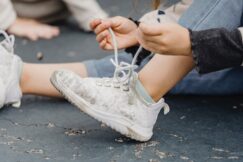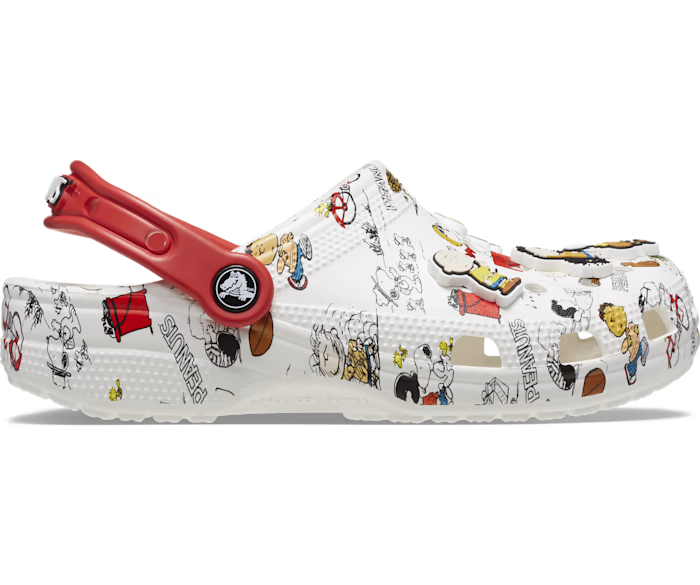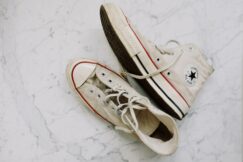How To Dry Shoes: 7 Quick and Easy Ways To Fix Wet Footwear
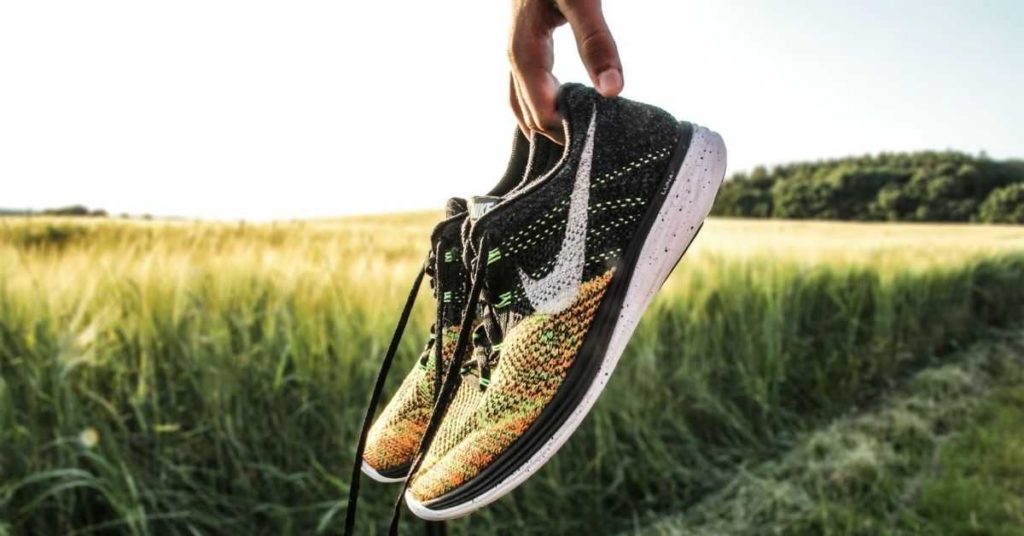
Have you ever walked in wet shoes for longer than you would have liked?
Stepped into puddles, accidentally spilled water on your shoes, or got caught in the rain and snow? It must’ve been a horrible experience, right?
Wet shoes are bad news, especially if you’re not sure how to dry shoes properly.
And despite how trivial that might sound to your ears, damp or wet shoes can be more than what meets the eye.
The longer your feet remain moist and enclosed in wet, closed shoes, the higher the chances of developing serious foot complications.
This can lead to soggy, wrinkled feet as well as blisters and painful cracks.
Prolonged moisture accumulation is also a perfect breeding ground for foot fungus and tinea pedis – the microbe that causes athlete’s foot.
Wet shoes can also ruin your shoes’ chances of survival: In other words, shave off years from their lifespan. We all have a pair of shoes we love and abuse daily.
However, if the shoes don’t get their fair share of TLC regularly, they will wear out faster than you can find time to fix them.
In this post, I’ll explain how to dry wet shoes properly so that you don’t have to replace them often.
Why Do Shoes Become Wet?
Why shoes become wet might seem obvious, but there is a definite backstory.
Your job may require you to be near water: landscaping, valeting, etc. Next, there’s bad weather and winter.
Together, all of these elements cause your shoes to become wet, giving rise to structural damage, mildew, stink, and squeaky sounds when you walk.
Often, we’re at fault. When we risk going outside with regular shoes, despite knowing about incoming unfortunate weather or a downpour.
The weather’s damp, but we still wear leather shoes when waterproof, or rain boots would do a better job at weatherproofing.
Also, at times we forget to wear socks and end up with sweaty bare feet, causing all the dampness. Most of us don’t prepare in advance, such as packing an extra pair of socks or shoes.
All is well, however, if you prepare and take precautionary measures in advance.
Let’s first discuss those measures before we move on to drying your shoes, and then I will answer your burning questions on how to dry shoes in a dryer.
Rotate Your Shoes
You shouldn’t wear the same shoes every day, because they won’t have time to dry completely for the next day.
It is best to alternate between two pairs of shoes, where one rests, and the other is dry and ready for the day ahead. Regularly wearing the same shoes shortens their lifespan and increases the chances of bacteria accumulation.
Nevertheless, if you have to wear the same shoes (due to uniform or likeability), buy two pairs of the same style. Or make sure they’re easily replaceable and not costly.
Plus, follow a regular maintenance routine.
Keep Extra Socks And Shoes
We cannot stress this enough! Spare socks and shoes are useful if yours become soggy around midday and you wish to change into a fresh pair.
In addition, if you are wearing rain boots and it stops raining once you reach your destination, you can change into your usual shoes to make yourself more comfortable.
Get neoprene or wool socks, and you won’t have sweaty feet or friction-causing blisters. Good, moisture-wicking socks are a better alternative to wearing shoes barefoot.
You can also protect your shoes from water by purchasing shoe liner bags – a cost-effective option to keep your shoes dry and water-resistant. As for saving socks from water, pull on a plastic bag over them and then wear your shoes.
This prevents sweat and dampness from leaking into the socks. While it may feel strange at first, you’ll find it highly effective in wet and cold weather: Moms use it all the time with their kids!
Apply Waterproofing Products
You can learn to dry shoes fast for your ease, but if your regular shoes get soaking wet every day, you cannot ignore investing in waterproof shoes.
As an alternative, you can use waterproofing products to make your shoes watertight.
Waterproof sprays, beeswax, and candle wax (such as tea light) are some products you can try to prime your shoes for wet weather.
Let me tell you; waterproofing doesn’t last forever, which is why you’ll need to repeat this process once the waterproof layer isn’t effective anymore.
Test the waterproofing products on a sample shoe or fabric to ensure it won’t stain.
How To Waterproof Shoes?
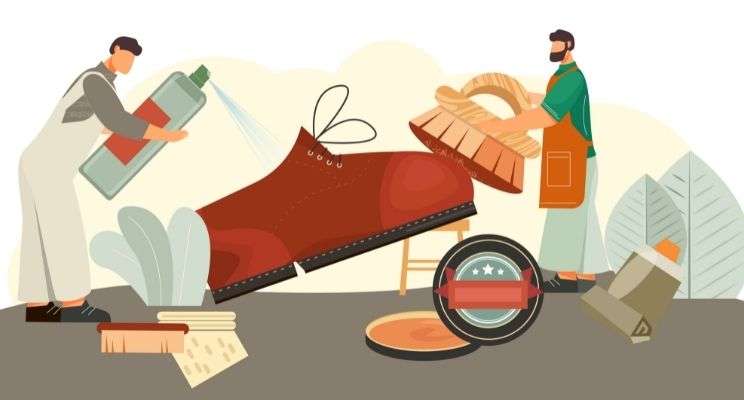
Using waterproof spray on shoes made of textured fabrics, such as canvas, hemp, and suede, is easier because their fabric is more absorbent.
The effect won’t wear off as quickly as with leather and synthetics; be sure to use waterproof spray specialized for your fabric.
Keep in mind; you can’t waterproof shoes with large vents, mesh, or drainage holes as the sealant won’t stick.
The key ingredients of a waterproof spray are silicon or acrylic polymers because they prevent mildew and water damage. You can find them in most shoe stores and outdoor clothing and equipment shops.
- It is important to start with clean, dry shoes before waterproofing them, so dirt does not seal in.
- Pull out the insoles (if they are removable) and hang the shoes by the laces in order to better access the shoes and prevent your hands from getting sprayed.
- You should do this outside or in your garage. If you cannot, do it in a well-ventilated area and place large newspapers under the shoes to prevent spray from spreading.
- Spray the shoes from a distance of 6 – 8 inches and spritz in a thin, even layer. Cover all parts suspected of leaks (especially the seams), but don’t drench them. Once you notice that the shoes have a glossy finish, they are done.
- Using a hand towel or microfiber cloth, wipe off the excess waterproof spray without rubbing too hard. The goal is to remove the spray from the eyelet, zippers, rubber details, and the surrounding outsole.
- A spray should dry within half an hour, but give your shoes 24 – 48 hours to air-dry completely, especially if you have applied over one coat. Allow the sealant to harden properly.
- Test your newly waterproof shoes before wearing them: You may need to repeat the process based on your usage and the weather.
Using Other Waterproofing Methods
Beeswax
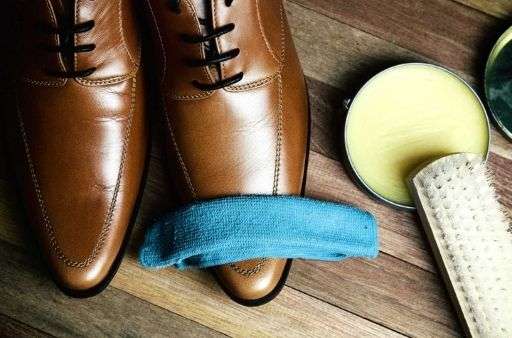
It’s ideal for all types of shoes and more effective than sprays, as beeswax is naturally water-repellent and absorbing.
Just take a solid piece of colorless, odorless beeswax and rub the product over the shoes, concentrating on areas you want to save from moisture until you see a thick layer forming.
Take a hairdryer and set it to the highest heat setting. Hold the dryer over the shoes back and forth, and you’ll immediately see the wax melting into the shoe.
Do one pair at a time until the wax disappears. The finished shoes will look similar to those you started with. When it dries, you’ll have freshly waterproof shoes!
Candlewax
This is a cheap alternative to beeswax. Make sure it’s clear and odor-free. Use it in the same manner as beeswax.
Caution
We don’t recommend Vaseline as you may risk staining or causing stubborn oil spots on your shoes. In the case of colored wax, make certain it matches the color of your shoes.
How To Dry Wet Shoes?
Several methods exist for drying wet shoes, from DIY hacks to the simplest tricks anyone can use to their advantage. Common sense says to place wet shoes near a heat source or in the sun.
However, if your shoes are leather, the above methods are not as straightforward as they may seem. Let’s look at what works to dry wet shoes.
Preparing The Shoes
- When your shoes are splattered with mud, clean them by getting into the grooves before the grit and debris hardens.
- Cotton, canvas, and rubber shoes can be washed or cleaned with mild detergent and a toothbrush.
- Avoid washing delicate materials such as leather, suede, gel, or hard-soled shoes. Instead, use a dry cloth to remove the mud.
- Remove the laces and insoles before cleaning to let the moisture evaporate faster.
- Hang the accessories to air-dry while you focus on the shoes.
The Heater/Furnace Hack
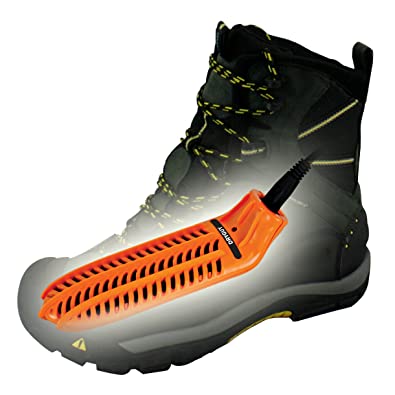
For shoes other than leather, placing them at a safe distance from the heater or furnace can get the job done.
Make sure to remove the laces and insoles, bring the tongue forward and give the shoes a good wipe with a dry cloth inside and out.
Next, let the hot air circulate inside and leave them to dry overnight.
I’ll advice using shoe dryer for quick results.
The Sun Hack
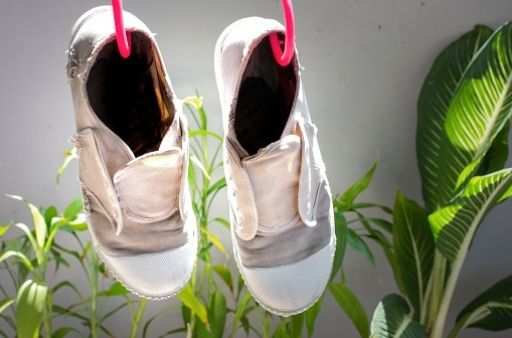
Allowing the shoes to dry outside is definitely a sensible method, especially if you’re wondering how to dry sneakers or running shoes, but don’t put your shoes in direct sunlight; just let the heat work its magic.
Don’t use some of these methods on leather as it could crack and become stiff. We will let you know!
The Newspaper Hack
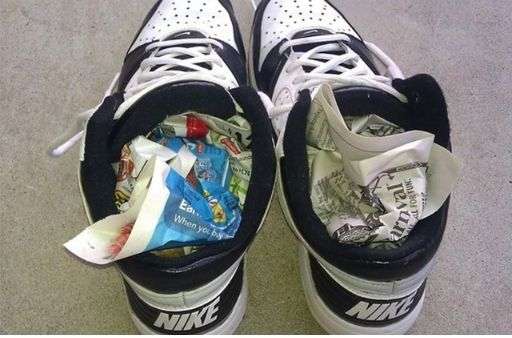
Newspapers perform well in combination with the heater/furnace method. I’ll explain why in a moment.
Newspapers or paper towels are great choices, as are magazines, provided they don’t stain the shoes. It is better to stick to newspapers than to feel sorry later.
Stuff some newspapers into your shoes and press with your hand until it soaks up all the moisture. Repeat this process until you notice the newspapers absorb less than when you started.
Place the newspaper-filled shoes near a heater or somewhere well ventilated, and air circulation will get rid of moisture. As soon as the newspapers become saturated, change them. Additionally, wrap the shoes in a newspaper and secure them with a rubber band to dry up the outside.
Wet shoes can be dried quickly and safely using this method. Works with any kind of shoe.
The Fan Hack
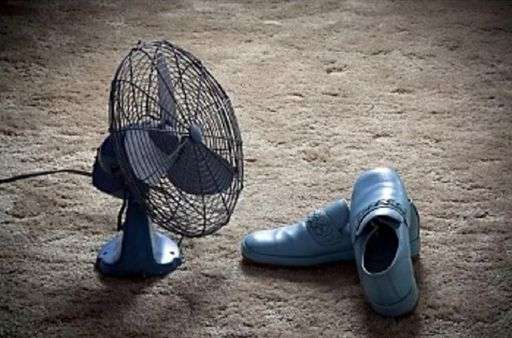
Using this hack for leather and gel-soled shoes works well, especially if you want to find out how to dry shoes quickly. And this way, the leather fabric also won’t get stiff, whereas if you use heaters or direct sun, it will shrink, become stiff and begin to crack.
1. Make use of a large fan, place a towel under the fan to catch any excess water, and undo the laces and insoles of the shoes.
2. Take a wire hanger and cut two inches off the wire with a wire cutter.
3. Using pliers, bend the cut wires into an S shape.
4. Hook each smaller end of the shaped wires into the fan.
5. Open your shoes from the tongue region and hang them by their open mouths. Let the fan access and remove the moisture from inside the shoes.
6. Set the fan to medium-high.
Alternatively, you could first use newspaper to dry the shoes, which is the best way to dry shoes and use a fan later to dry the remaining areas.
Dry the shoe accessories in the dryer (if they are not leather) or hang them with clothes hangers where the air can reach them.
How To Dry Shoes In Dryer?
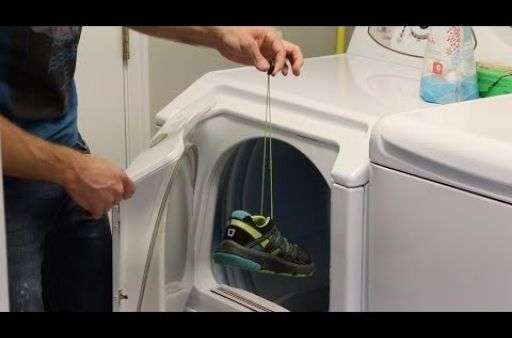
Can you put shoes in the dryer?
Yes, in an emergency, this method works fine. However, it’s not recommended for leather and suede, hard-soled, and gel shoes because they may warp, become shapeless, and the glue may begin to separate.
- Remove the laces and yank out the insoles.
- Open the dryer door and place the shoes inside, with outward soles facing the mirror.
- To help reduce noise, place some towels or dry sheets (don’t load up the dryer).
- You need to secure the shoelaces at the top of the dryer door with the laces halfway out.
- For drying shoes in dryer, turn it on medium or low for 60 minutes.
- Check the shoes after 60 minutes to see if they are dry.
Even if there’s still some moisture inside, a few blows of cool air or quick shots of hot air using a hairdryer will resolve the issue.
You can also use baking soda or talcum powder to dry the inside of your shoes, which will deodorize them and make them smell fresh as a bonus.
Frequently Asked Questions
How do you dry shoes properly?
It depends on how wet your shoes are. It’s best to wash wet and caked-on dirt from canvas or fabric shoes or to clean them with a toothbrush and mild detergent in their already wet state. If you’re dealing with wet leather or suede, wipe it down with a clean cloth only. u003cbru003e u003cbru003eRemove the insoles and laces from your shoes, and stuff them with newspaper balls. As soon as the papers are saturated, you need to change them. It takes 8 hours to dry your shoes properly, especially if you place them before a fan, but it’s the u003cstrongu003ebest way to dry shoesu003c/strongu003e.
Is it okay to put shoes in the dryer?
That’s the most common question we get. u003cbru003e u003cbru003eAs long as you follow the steps in this post, you can try u003cstrongu003edrying shoes in dryeru003c/strongu003e. Do not practice this on leather and suede, gel-soled, and hard-soled shoes, as they can shrink and stiffen. u003cbru003e u003cbru003eYou must use a dryer as a last resort when you’re wondering u003cstrongu003ehow to dry shoes fastu003c/strongu003e because you need them within a few hours or ready for work the next morning. u003cbru003e u003cbru003eHowever, if you have more time on your hands, we recommend drying your shoes slowly, since u003cstrongu003edrying shoes in a dryeru003c/strongu003e does come with disadvantages, such as reducing the lifespan of your shoes.
How long do shoes take to air dry?
Although, if you dry your shoes first with newspapers and then let them air dry, your footwear will dry quicker. Air drying takes 24-48 hours, depending on the amount of water in the shoes. u003cbru003eu003cbru003eThough, if that’s too much for you, check out our hacks above that will assist you on u003cstrongu003ehow to quickly dry shoesu003c/strongu003e.
How do you dry wet sneakers?
If you’re wondering u003cstrongu003ehow to dry sneakersu003c/strongu003e, it’s easy. Ensure your sneakers are clean by giving them a brush wash to remove dirt stains and mud or wipe them only if they have gel soles to avoid separating the glue. u003cbru003e u003cbru003eAs explained in this post, you can dry the inside and outside with newspapers. You can let them dry in the sun or a well-ventilated area. To learn more about u003cstrongu003ehow to dry sneakersu003c/strongu003e, check out our tips in the hacks section.
Why do my shoes smell after getting wet?
Wearing wet shoes too long without drying them will cause them to stink. The causes of stinky shoes include sweat, soiled socks, prolonged moisture, bacterial growth, and minimal maintenance. u003cbru003e u003cbru003eIt could also be the way you store them. Please do not leave your gym shoes in a gym bag; instead, place them in a warm, windy place to dry. You shouldn’t store them in plastic boxes because they block air circulation. u003cbru003e u003cbru003eKeep your shoes in tip-top shape by storing them in fabric bags made of breathable materials. Make sure you keep shoes free of moisture, odor-free, and in shape by using cedar shoe trees. Rather than leaving them on the floor, hang or lean them against a wall for air circulation, as this will prevent the outsole from absorbing moisture.
Conclusion
I have shared some effective methods and the best way to dry shoes with you: the newspaper technique. You won’t have to worry about replacing your shoes more often if you follow these methods.
These tips work for anyone looking to dry shoes in a pinch or for those who wish to observe the recommended precautionary measures for drying their expensive footwear.
If you have better suggestions on how to dry shoes faster and properly, let us know in the comments.
